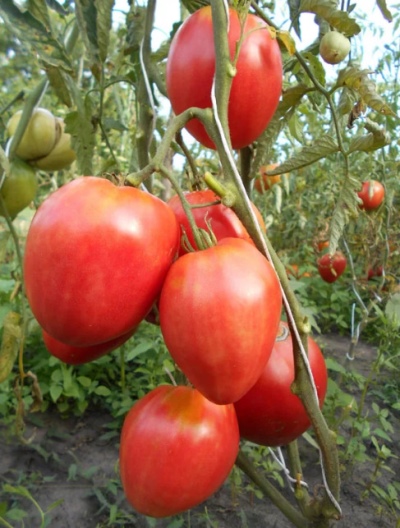
- Authors: USA
- Name synonyms: Mrs. Schlaubaugh's Famous Strawberry
- Category: grade
- Growth type: indeterminate
- Appointment: universal
- Ripening period: mid-season
- Ripening time, days: 110-120
- Growing conditions: for greenhouses
- Bush height, cm: 190-200
- Bush characteristic: fine structure
Those gardeners and farmers who like to grow giant tomatoes should pay attention to the exotic and incredibly productive tomato variety, Mrs. Schlaubach's famous strawberry, which is most productive when grown in greenhouse conditions.
Breeding history
This mid-season tomato is a prominent representative of American selection. The nightshade crop was bred more than 10 years ago, having won the sympathy of many farmers. Recommended for growing tomato in all climatic zones of the country. The highest yields are observed when growing vegetables in greenhouse conditions.
Description of the variety
Tomato Mrs. Schlaubach's famous strawberry is a tall plant of an indeterminate type. The bushes grow up to 190-200 cm. The tomato bush is characterized by a strong central stem and flexible liana-like branches, moderate thickening of green foliage, a developed root and simple inflorescences. In each fruit cluster, from 4 to 6 fruits are formed.
When growing a vegetable crop, it is necessary to form a bush in 2 stems, regularly remove unnecessary stepsons and tie the plant to supports, since giant tomatoes can deform and break off fragile branches.
The main qualities of the fruit
American selection tomatoes represent a class of large-fruited nightshade. Under favorable conditions and proper care, fruits gain a mass of 200-400 grams. The shape of the vegetable is very beautiful and unusual - heart-shaped with a perfectly smooth surface. Tomatoes sometimes grow with a slight ribbing surface and a slightly elongated heart shape. Ripe tomato is evenly covered with a pink-raspberry color. At the stage of technical maturity, the berries are light green in color without darkening at the base. The peel of the vegetable is moderately dense, glossy, but not tough.
The variety is characterized by resistance to cracking, good transportability and average keeping quality. Only overripe berries can crack.
The variety has a universal purpose, so tomatoes are eaten fresh, added to salads and other dishes, pickled, processed into dressings and drinks.
Taste characteristics
The taste of American-selected tomatoes is excellent. The flesh of the vegetable is tender, fleshy, very juicy and with a low content of seeds. The taste of the giant tomato is balanced. It is dominated by sweetness, complemented by a slight sourness. The aroma of the vegetable is pronounced, dessert, with fruity notes. The taste of ripe tomatoes is revealed to the maximum.
Ripening and fruiting
The tomato species belongs to mid-season nightshade crops. From the mass germination of seedlings to ripe fruits on fruit clusters, 110-120 days pass. Tomatoes are ripened gradually. You can taste the first tomatoes in the second half of July. The peak of fruiting occurs in July-August.
Yield
The yield indicators of the variety are high, the main thing is to observe agricultural technology. On average, about 8-10 kg of ripe tomatoes can be grown and harvested per 1 m2. Outdoors, yields are slightly lower.
The timing of planting seedlings and planting in the ground
The culture is grown through seedlings.The seeds must be sorted out, disinfected and treated with a growth activator. Sowing is carried out in the second half of March. Seedlings emerge after 6-8 days. Seedlings grow well under certain temperature and light conditions. At the stage of appearance of 2-3 leaves, the plants are seated in separate cups. Further, fertilizing and watering of the bushes are carried out. A week before transplanting into the greenhouse, the bushes are carefully prepared - they are hardened daily.
Transplantation to a permanent place of growth is carried out in May. At this point, the bushes are already 50-60 days old.

Growing tomato seedlings is an extremely important process, because it largely depends on whether the gardener will be able to harvest at all. All aspects must be taken into account, from seedbed preparation to planting in the ground.
Landing scheme
Tomatoes require not only care, but also proper placement in the beds. It is recommended to plant no more than 3 bushes per 1 m2. It is this arrangement that will provide access to the sun and oxygen for each plant. The correct scheme for planting is 70x70 cm.

Growing and care
The variety is completely unpretentious in care, the main thing is to choose the best suitable place for growth - loose, fertile, breathing soil. Care is standard: watering, feeding, weeding and loosening the soil, shaping, garter and pinching bushes, airing the greenhouse, as well as protecting against viruses and insects.




A plant needs different micronutrients at each stage of growth. All fertilizers can be divided into two groups: mineral and organic. Folk remedies are often used: iodine, yeast, bird droppings, eggshells.
It is important to observe the rate and period of feeding. This also applies to folk remedies and organic fertilizers.
Disease and pest resistance
Disease resistance of the variety is good. It is able to withstand many diseases and viruses, including tobacco mosaic virus, fusarium wilt, and root rot. Plants are protected from insects by special spraying with insecticides.


Resistant to adverse weather conditions
Tomato has a high resistance to stress, so it can withstand sudden temperature jumps, short-term droughts and heat. Drafts and excessive moisture negatively affect the variety.

























































































